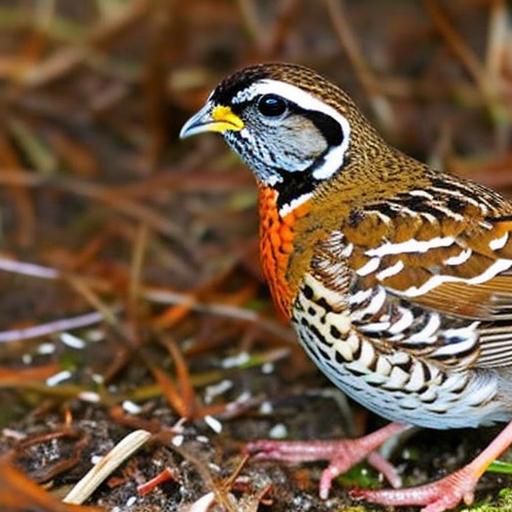Proper brooder temperature is crucial for the health and well-being of quail chicks. When quail chicks are first hatched, they are unable to regulate their body temperature and rely on the brooder to provide the warmth they need to survive. Maintaining the correct brooder temperature is essential for the chicks to thrive and grow into healthy adult quail. If the brooder temperature is too low, the chicks can suffer from cold stress, which can lead to decreased growth rates, weakened immune systems, and even death. On the other hand, if the brooder temperature is too high, the chicks can suffer from heat stress, which can also lead to decreased growth rates, dehydration, and death. Therefore, it is crucial for quail farmers to pay close attention to the brooder temperature and make sure it is within the ideal range for the chicks’ development.
Proper brooder temperature is also important for the overall success of a quail farming operation. When quail chicks are raised in an environment with the correct brooder temperature, they are more likely to grow at a healthy rate, have a lower mortality rate, and have a stronger immune system. This can ultimately lead to higher productivity and profitability for quail farmers. Additionally, maintaining the proper brooder temperature can help prevent behavioral issues in quail chicks, such as feather pecking and cannibalism, which can arise from stress caused by improper environmental conditions. Overall, ensuring the proper brooder temperature for quail chicks is essential for their health and well-being, as well as for the success of a quail farming operation.
Key Takeaways
- Proper brooder temperature is crucial for the health and growth of quail chicks.
- The ideal temperature range for quail brooder is between 95-100°F for the first week, decreasing by 5°F each week until reaching room temperature.
- It is important to monitor and adjust brooder temperature regularly to ensure it stays within the ideal range.
- Incorrect brooder temperature can lead to health issues, stunted growth, and even death in quail chicks.
- Tips for maintaining optimal brooder temperature include using a reliable thermometer, adjusting heat sources, and providing a draft-free environment.
Ideal Temperature Range for Quail Brooder
The ideal temperature range for a quail brooder is between 95-100 degrees Fahrenheit during the first week of the chicks’ lives. As the chicks grow and develop feathers, the brooder temperature can be gradually reduced by 5 degrees each week until it reaches the ambient temperature. It is important to note that these temperature ranges are general guidelines and may need to be adjusted based on the specific needs of the quail chicks and the environmental conditions of the brooder. Quail chicks that are too cold will huddle together and chirp loudly, while quail chicks that are too hot will move away from the heat source and pant. Therefore, it is important for quail farmers to closely monitor the behavior of the chicks and adjust the brooder temperature accordingly.
In addition to maintaining the proper brooder temperature, it is also important to provide a draft-free environment for the quail chicks. Drafts can cause fluctuations in temperature within the brooder, which can stress the chicks and lead to health issues. It is also important to provide a source of light in the brooder to help regulate the chicks’ circadian rhythms and encourage healthy growth and development. Overall, maintaining an ideal temperature range in the quail brooder is essential for the health and well-being of the chicks during their critical early stages of life.
Monitoring and Adjusting Brooder Temperature
Monitoring and adjusting the brooder temperature is a critical task for quail farmers to ensure the health and well-being of their chicks. There are several methods that can be used to monitor the brooder temperature, including using a thermometer placed at chick level, observing the behavior of the chicks, and using automated temperature control systems. It is important to check the brooder temperature regularly throughout the day, as environmental conditions can change and affect the temperature within the brooder. Additionally, it is important to monitor the temperature at different areas within the brooder to ensure that there are no hot or cold spots that could affect the chicks.
If the brooder temperature is too high or too low, it is important to take immediate action to adjust it. This can be done by adjusting the height of the heat source, increasing or decreasing ventilation, or using supplemental heating or cooling devices as needed. It is important to make gradual adjustments to avoid shocking the chicks with sudden changes in temperature. Quail farmers should also be prepared to make adjustments based on external factors such as changes in weather or power outages that can affect the brooder temperature. Overall, monitoring and adjusting the brooder temperature is a crucial task for quail farmers to ensure that their chicks are provided with a comfortable and healthy environment for optimal growth and development.
Potential Risks of Incorrect Brooder Temperature
Incorrect brooder temperature can pose several risks to quail chicks and can have serious consequences for their health and well-being. If the brooder temperature is too low, quail chicks can suffer from cold stress, which can lead to decreased growth rates, weakened immune systems, and increased susceptibility to diseases. Cold stress can also lead to higher mortality rates among quail chicks, which can have a significant impact on a quail farming operation. On the other hand, if the brooder temperature is too high, quail chicks can suffer from heat stress, which can lead to dehydration, decreased growth rates, and even death. Heat stress can also lead to behavioral issues such as feather pecking and cannibalism, which can have long-term effects on the health and productivity of adult quail.
In addition to health risks, incorrect brooder temperature can also have financial implications for quail farmers. Chicks that are exposed to incorrect brooder temperatures are more likely to have stunted growth and lower productivity as adults, which can result in lower profits for quail farmers. Additionally, higher mortality rates among quail chicks due to incorrect brooder temperature can lead to increased production costs and decreased overall profitability for a quail farming operation. Therefore, it is crucial for quail farmers to prioritize maintaining the proper brooder temperature to mitigate these potential risks and ensure the success of their flock.
Tips for Maintaining Optimal Brooder Temperature
Maintaining optimal brooder temperature for quail chicks requires careful attention and proactive measures from quail farmers. One effective tip for maintaining optimal brooder temperature is to use a reliable thermometer placed at chick level within the brooder. This allows quail farmers to accurately monitor the temperature and make necessary adjustments as needed. It is also important to provide a heat source that is adjustable in height so that it can be positioned at an appropriate distance from the chicks to maintain the ideal temperature range. Additionally, using supplemental heating or cooling devices can help regulate the brooder temperature in cases where environmental conditions fluctuate.
Another tip for maintaining optimal brooder temperature is to provide a draft-free environment for the quail chicks. This can be achieved by sealing any gaps or openings in the brooder and ensuring that there are no drafts that could cause fluctuations in temperature. It is also important to provide adequate ventilation in the brooder to prevent overheating while maintaining a consistent temperature. Lastly, providing a source of light in the brooder can help regulate the chicks’ circadian rhythms and encourage healthy growth and development. By implementing these tips, quail farmers can ensure that their chicks are provided with a comfortable and healthy environment for optimal growth and development.
Common Mistakes to Avoid When Heating Quail Brooder

When heating a quail brooder, there are several common mistakes that quail farmers should avoid to ensure that their chicks are provided with a safe and comfortable environment for optimal growth and development. One common mistake is using an unreliable or inaccurate thermometer to monitor the brooder temperature. This can lead to incorrect temperature readings and prevent quail farmers from making necessary adjustments to maintain the ideal temperature range for their chicks. It is important for quail farmers to invest in a high-quality thermometer placed at chick level within the brooder to accurately monitor the temperature.
Another common mistake is providing inadequate ventilation in the brooder, which can lead to overheating and poor air quality for the quail chicks. It is important for quail farmers to ensure that there is proper ventilation in the brooder to prevent heat buildup while maintaining a consistent temperature. Additionally, using a heat source that is not adjustable in height can lead to uneven heating within the brooder and make it difficult to maintain the ideal temperature range for the chicks. Quail farmers should use a heat source that can be easily adjusted in height to ensure that it is positioned at an appropriate distance from the chicks.
Lastly, another common mistake is failing to provide a draft-free environment for the quail chicks, which can lead to fluctuations in temperature and stress for the chicks. Quail farmers should seal any gaps or openings in the brooder to prevent drafts and ensure that there are no fluctuations in temperature that could affect the health and well-being of their chicks. By avoiding these common mistakes when heating a quail brooder, quail farmers can provide their chicks with a safe and comfortable environment for optimal growth and development.
Ensuring a Healthy and Thriving Quail Flock
In conclusion, maintaining proper brooder temperature is essential for ensuring a healthy and thriving quail flock. The ideal temperature range for a quail brooder is between 95-100 degrees Fahrenheit during the first week of the chicks’ lives, with gradual reductions as they grow and develop feathers. Monitoring and adjusting the brooder temperature is crucial for preventing potential risks such as cold or heat stress, which can have serious consequences for the health and well-being of quail chicks. By implementing tips such as using reliable thermometers, providing adequate ventilation, and avoiding common mistakes when heating a quail brooder, quail farmers can ensure that their chicks are provided with a safe and comfortable environment for optimal growth and development.
Ultimately, maintaining proper brooder temperature is not only important for the health and well-being of quail chicks but also for the overall success of a quail farming operation. By prioritizing proper brooder temperature, quail farmers can mitigate potential risks, prevent health issues, and ultimately achieve higher productivity and profitability in their flock. Therefore, it is crucial for quail farmers to pay close attention to maintaining optimal brooder temperature as part of their commitment to ensuring a healthy and thriving quail flock.
When raising quail, it’s crucial to maintain the right temperature in the brooder for their optimal growth and health. To learn more about the specific temperature requirements for quail brooders, check out this informative article on PoultryWizard.com. In addition, if you’re interested in expanding your poultry knowledge, you might also want to read about how many eggs geese lay and whether geese can eat chicken feed. Click here to explore these fascinating topics.
FAQs
What is the ideal temperature for a quail brooder?
The ideal temperature for a quail brooder is around 95-100 degrees Fahrenheit for the first week, and then it can be gradually reduced by 5 degrees each week until it reaches the ambient temperature.
How do I maintain the temperature in the quail brooder?
You can maintain the temperature in the quail brooder by using a heat lamp, heat plate, or infrared heater. It’s important to regularly monitor the temperature and adjust the heating source as needed.
What are the signs of the brooder being too warm or too cold for the quail?
Signs that the brooder is too warm for the quail include panting, spreading their wings, or staying away from the heat source. Signs that the brooder is too cold for the quail include huddling together, chirping loudly, or being lethargic.
Can I use a thermometer to monitor the temperature in the quail brooder?
Yes, using a thermometer is a great way to monitor the temperature in the quail brooder. Place the thermometer at the same height as the quail to get an accurate reading of the temperature they are experiencing.
What should I do if the temperature in the quail brooder is too warm or too cold?
If the temperature in the quail brooder is too warm, you can raise the heat source higher or use a lower wattage bulb. If the temperature is too cold, you can lower the heat source or use a higher wattage bulb. Regularly monitor the temperature and make adjustments as needed.
Meet Walter, the feathered-friend fanatic of Florida! Nestled in the sunshine state, Walter struts through life with his feathered companions, clucking his way to happiness. With a coop that’s fancier than a five-star hotel, he’s the Don Juan of the chicken world. When he’s not teaching his hens to do the cha-cha, you’ll find him in a heated debate with his prized rooster, Sir Clucks-a-Lot. Walter’s poultry passion is no yolk; he’s the sunny-side-up guy you never knew you needed in your flock of friends!







